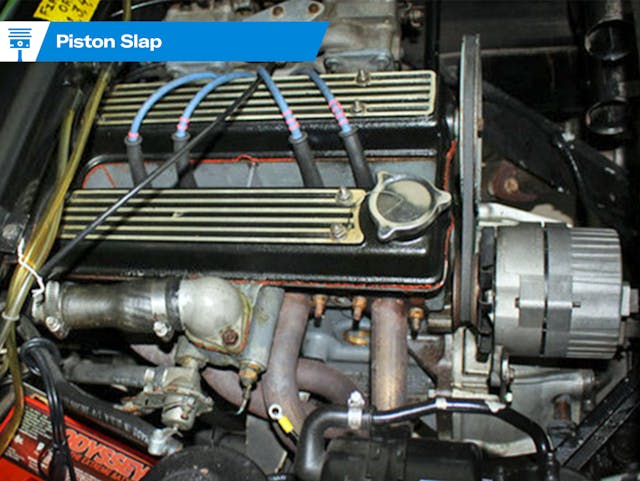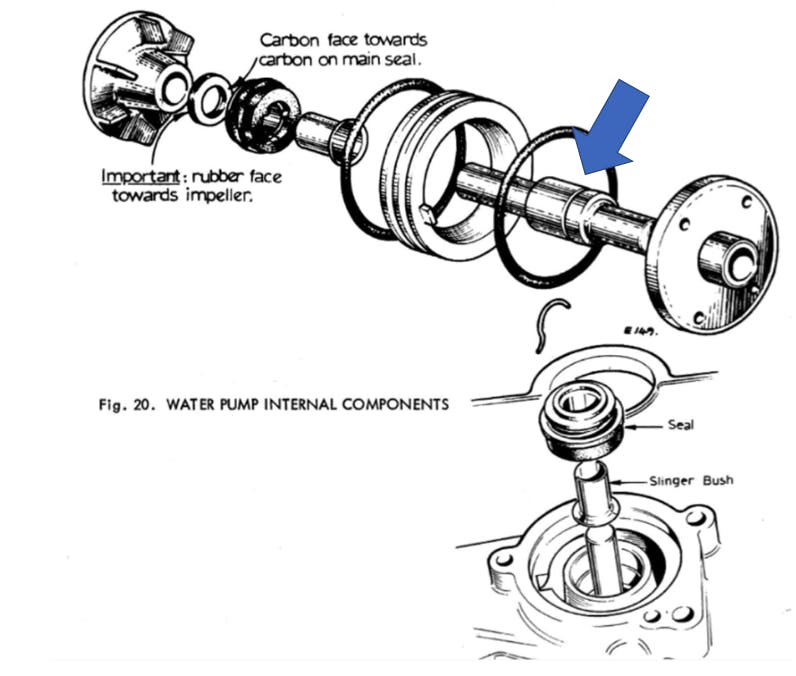Piston Slap: Intolerance for a deflected Lotus water pump?

Paul writes:
I have a 1972 Lotus Twin Cam, and the water pump became loose within 3000 miles of an engine rebuild. (It was rebuilt by Miles Wilkins in England.) There’s deflection at the tip of the water pump shaft with the pulley removed, it’s 0.015 inches, or 0.4 mm. This deflection remained stable for the last 15,000 miles since I swapped over to a looser belt. My cooling system appears consistent with most other twin cam vehicles, and as water pump replacement involves engine removal and partial disassembly, I am hesitant to do so without good advice.
No one appears willing to venture a number on allowable water pump deflection, and every other pump I’ve touched had essentially no play. But mine has soldiered along for 1000s of miles! Can Hagerty can find a Lotus Twin Cam Engine God that can venture an answer to this burning question of acceptable water pump deflection, or shall I just accept the inevitable aspect of Lotus ownership, fear of mechanical failure at the worst possible time?
Sajeev answers:
Since the amount of tolerable water pump shaft play for a nearly 60-year-old engine isn’t common knowledge around the Internet—and since the Internet is crucial to the Piston Slap schtick—I checked if 0.015 inches of play is within spec for your average ball bearing. Turns out it is not, and its out of spec by a large margin. My uneducated advice is to go ahead and replace the water pump, even if the labor cost will be beyond painful.
Concerning for sure, but that doesn’t necessarily help Paul with his water pump. So I asked around the Hagerty metaverse for a Lotus expert. And would you believe I not only found an expert, but I found one with firsthand experience on the matter? So without any further ado …
Bill answers:
Hi Paul, that’s a great question and observations on your part, as these Twin Cam water pumps truly are notorious for being problematic. However, with careful installation they are fairly reliable—it just takes a little finesse and attention to detail.
The pump itself is fairly simple, but considering it is integral to the aluminum timing chest, as you note, access to it is not as simple as with other cars. The best method is, in fact, to remove the cylinder head, which does allow for refreshing the timing chest gaskets, front crank seal, and timing chain if you’re so inclined. These are pressed into the aluminum timing chest housing, which can sometimes crack during assembly, and the internal seals must be checked carefully when installing the impeller on the back (internal) side. Damage can also be done to the bearings if pressed in improperly, too forcefully, or misaligned.
The pump shaft and bearing assembly (installed as a sealed cartridge) utilizes a dual row ball bearing design, to keep the shaft aligned and resist radial loading, such as from the drive belt tension. The exposed length of the pump shaft is the shorter length from the bearing—the longer length reaches back through the casing, seals, and to the impeller.

With 0.015 inches of measurable play on the outer end of the shaft, this will translate to more play at the impeller side. While this doesn’t seem to be a lot of movement, most ball bearings allow for only 1/10th of that play in radial runout. Like you, all of the new water pump bearing assemblies I’ve installed have no measurable play, nor should they.
To me, your water pump is showing signs of needing replacement. In a Lotus Elan, where there is an alternator installed, the belt tension is higher and the radial load is higher. In a Europa, because there is no additional pulley (the crank pulley is only driving the water pump pulley), the belt tension is “almost” negligible. While your pump may still function (there should be enough clearance between the impeller and back of the housing to allow for some movement), the play will likely get worse over time and can accelerate seal failure, both at the bearings and internally. I’m a bit surprised it is not leaking, had it been installed in an Elan it may well be!”
Have a question you’d like answered on Piston Slap? Send your queries to pistonslap@hagerty.com, give us as much detail as possible so we can help! If you need an expedited resolution, make a post on the Hagerty Community!

